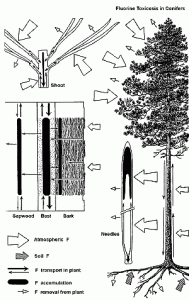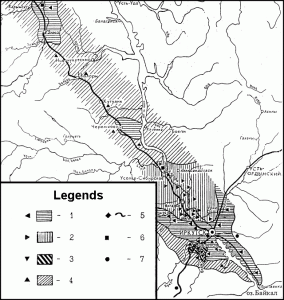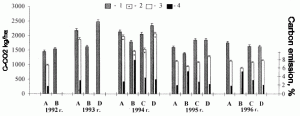Siberian Institute of Plant Physiology and Biochemistry,
SB RAS, Irkutsk
Head of the Institute:
Ryurik K.Salyaev, Corresponding Member of the RAS
P.O.Box 1243, Irkutsk, 664033, Russia
Tel.: (3952) 460721.
Fax: (3952) 510754.
email: root@sifibr.irkutsk.su
Principal researchers:
A.S.Pleshanov, Doctor of Sciences (Biology), Head of the Laboratory;
L.V.Pomazkina, Doctor of Sciences (Biology, Head of the Laboratory;
T.A.Mikhailova, Doctor of Sciences (Biology), Principal researcher;
V.I.Voronin, PhD (Biology), Head of the Laboratory;
V.I.Epova, PhD (Biology), Senior researcher
Project objectives
The main aim of the project is to establish diversity of terrestrial ecosystems of the world heritage site, the Baikal Region, their resistance to the impact of natural and anthropogenic factors, and optimisation of the monitoring system, protection and nature use. The following sections are involved therewith:
- Retrospective and prognostic assessment of climatic changes on the basis of dendroclimatic information obtained in the Pribaikalie area (responsible worker V.I.Voronin).
- Estimation of injurious needle biting insects as an indicator of the risk of a natural character (responsible worker V.I.Epova).
- Inventory of rare, relict and endemic plant and animal species, unique nature communities and study of the character of their distribution as a basis for monitoring and maintenance of biological diversity of the Baikal Region (responsible worker A.S.Pleshanov, assistant director).
- Assessment of degradation of forest ecosystems affected by air emissions of industrial enterprises (responsible worker T.A.Mikhailova).
- Study of CO2 emission and destruction of the organic matter in industrially polluted arable soils of the forest-steppe of Pribaikalie (responsible worker L.V.Pomazkina).
Background and significance of objectives
Dendroclimatic monitoring is determined by the demand to prevent crucial situations resulting from global changes of the climate. Continuous instrumental observations of the climate in Pribaikalie cover as little as one century and cannot serve as a basis for revealing century and super-century natural fluctuations of the climate and determination of its background dynamics. The investigations performed earlier in Pribaikalie have shown that it is possible to obtain long-term (over 500 years) chronologies according to the width of the annual tree rings, which contain the information on the dynamics of temperature and precipitation. More than 30 dendrochronological scales have been obtained to date covering recent 300-500 years, which are used to study climatic changes in the context of global changes.
The original many-year studies and summary of extensive literature data have resulted in compiling a land-survey of needle biting pests of the Baikal Siberia (Epova, 1999). Methods have been elaborated to determine conditions of outbreaks of forest pests. A 1:7500000 map of injurious insects has been complied for the first time for the whole area of Siberia and the Far East (Epova, Pleshanov, 1995). More detailed studies have been performed in the Baikal Siberia with regard to the anthropogenic effect on forest ecosystems (Pleshanov, Epova, 1996). Methods of mapping of the assessment of injurious pests are necessary for planning forest protection measures and enhancing their efficiency.
It is not unusual that selection of specially protected areas is of a subjective character. In this connection, the development of formalised methods of assessment of unique nature areas acquires a particular importance. The adoption of these methods can promote the efficiency of protection of biological diversity of large regions. The Institute has proposed new criteria for assessment of unique character of particular plant and animal species and the whole natural communities and developed original approaches to cartographic inventarisation of their habitats (refugium zones). The results of these investigations are important for optimisation of the network of specially protected natural areas of the Baikal Region (Pleshanov, 1998).
Ecologo-physiological investigations of coniferous forests of the Baikal Region polluted by industrial emissions have been performed by the researchers involved in the project using full-scale and experimental methods. A phytotoxic effect of air pollutants being primary for the region has been examined. The ways of admission of pollutants into plants, their movement, localisation in organs and tissues and removal from the plant organism have been studied by the example of fluorides (Fig. 4.1). The differences in the development of the pathological process have been found under critical, chronic and insidious types of damage. New methods of mapping of the state of forests in polluted areas are elaborated (Fig. 4.2). The results obtained promote carrying out a comprehensive ecologo-economic assessment of the current state of forests and predicting changes under different scenarios of technological risk.
Monitoring observations have been performed since 1990 of the humus state, the content of carbon of microbial biomass and CO2 emission in agroecosystem soils including industrially polluted ones (Fig. 5.1).
The project envisages to continue examinations on the basis of agroecological monitoring including assessment of soil properties and their pollution, the state of humus, its microbial transformation and CO2 emission from soils in many-year field experiments.
Research plan: approaches and methods
The methods of investigations are based on the officially accepted principles of dendroclimatic analysis developed by home and foreign scientists (Douglass, 1928, 1936; Huber, 1943; Frits, 1976; Shiyatov, 1980, 1986, etc.). The results obtained were treated with the use of a package of special programs developed at the Arizon University (USA), the Institute of Ecology of Plants and Animals of the Ural Branch of the Russian Academy of Sciences and at the Forest Institute of the Siberian Branch of the Russian Academy of Sciences. The samples will be selected according to the net of 100 x 100 km in the regions where one can obtain chronologies with significant climatic information about temperatures in high mountains and about precipitation in lowlands.
In addition to traditional forest-pathological methods, physiologo-biochemical, dendroindication and cartographic approaches permitting one to obtain unbiased results are developed at the Institute to estimate an injurious character of phyllophagous insects.
Traditional methods of performing floristic and faunistic works, as well as an original cartographic method of predicting habitats of relict plants and animals not found earlier are used at the Institute (Pleshanov, 1997). A full-scale verification of the method showed its high efficiency; in particular, a relict ecosystem of a nature-zonal rank, broad-leaved forests of Japanese elm tree have been first found in the Baikal Region.
Besides traditional approaches for pathological examination of forests, a number of adapted methods of ecologo-physiological estimation of particular components of forest ecosystems are used. Also, original approaches are used for mathematical analysis of ecological data and their cartographic representation.
The methods of agroecological monitoring are applied, and interrelating observations of hydrothermal characteristics of soils, the content of microbial biomass (the method of rehydratation) and CO2 emission after 7-15 days (the method of absorption) are performed in many-year field experiments. The fraction and group composition of humus is determined by the Ponomareva-Plotnikova method.
Expected results
Dendrochronological investigations are envisaged to result in the creation of a net of testing ground in Pribaikalie, revealing the relation of the tree increment to the average monthly air temperature and precipitation, obtaining long-term (300-600 years) absolute chronologies according to the width of annual tree rings and their climatic interpretation.
The faunistic, ecological and cartographic data obtained for phyllophagous insects serve as a basis for optimisation of regional systems of forest protection and running of monitoring of forest insects.
Inventarisation of rare and relict plants and animals will result in the creation of land-survey maps of their occurrence and biocoenotic maps of refugium zones (Pleshanov et al., 1990). These materials can be directly used for further planning of specially protected nature areas.
The system of assessment of the state of forests polluted by industrial emissions is envisaged to be substantiated. A full set of basic parameters in key full-scale plots (more than 80) will be obtained. The results to be obtained will be cartographically summarised. An algorithm of the adoption of preventive and reforestation measures will be developed.
It is planned to show the effect of hydrothermal conditions on seasonal and many-year dynamics of carbon of microbial biomass and CO2 emission from soils to determine a contribution of CO2 admission into the atmosphere, and to assess microbial transformation of the organic matter and carbon losses depending on industrial soil pollution.
List of publications of participants related to the project
-
Voronin V.I. Formation of the annual tree ring and dynamics of radial increment of Siberian fir in Khamar-Daban // Climate and vegetation of the Southern Baikal region. ñ Novosibirsk: Nauka Pub. House, 1989. ñ P. 116-122.
-
Glyzin A.V. The change of radial increase of Larix sibirica in the high-mountain areas of Pribaikalie (Baikalsky mountain ridge) // Silviculture. ñ M.: Nauka, 1993. ñ No 6. ñ P. 20-26.
-
Glyzin A.V. Spatial and time concordance of annual increase of trees in Pribaikalie // Ecological and physiological aspects of xylogenesis in conifers // Abstracts and programme of international conference IUFRO (August 6-10, 1996). ñ Krasnoyarsk: IF. ñ 1996. ñ P. 49-50.
-
Epova V.I., Pleshanov A.S. The zones of injurious phyllophagous insects of the Asian Russia. ñ Novosibirsk: Nauka. Siberian Publ. House of the Russian. Acad. Sci., 1995. ñ 47 p.
-
Pleshanov A.S., Epova V.I. (collection paper monograph). The present and future of the Baikal region. Part 1. ñ Novosibirsk: Publ. House Siberian Branch, Russian Acad. Sci., 1996. ñ112 p.
-
Epova V.I. A summary of the fauna of needle-biting insects of the Baikal Siberia. ñ Novosibirsk: Nauka, 1999 (in press).
-
Pleshanov A.S., Bardunov L.V., Makryi T.V. et al. The unique objects of living nature of the Baikal drainage basin. ñ Novosibirsk: Nauka, 1990. ñ 224 p.
-
Pleshanov A.S. A cartographic inventarisation of the refugia of the Baikal region // Deposited in VINITI, 30.12.97. No 3820-B97. ñ 32 p.
-
Pleshanov A.S. The aspects of genesis of relict nemoral complexes of Baikal Siberia // The study of the flora and vegetation of Zabaikalie. – Ulan-Ude: Publ. House Buryat State Univ., 1998. ñ P. 522-55.
-
Rozhkov A.S., Mikhilova T.A.. The effect of fluorine-containing emissions on conifers. Springer-Verlag: Berlin, Heidelberg, 1993. ñ 142 p.
-
Pleshanov A.S., Mikhilova T.A. A formalized method of mapping of air pollution of vegetation by industrial emissions // Ecological problems of urbanized territories. ñ Irkutsk: The Institute of Geography of Siberian Branch of Russian Acad. Sci., 1998. ñ P. 100-105.
-
Mikhailova T.A. Resistance of Larix sibirica and L. gmelini to gaseous pollutants in comparison with other conifers. Larix-98: World resources for breeding, resistance and utilization // Abstracts IUFRO Interdivisional Symposium, September, 1998. Krasnoyarsk, Russia. ñ P. 65.
-
Pomazkina L.V., Lubnina E.V., Zorina S.Yu., Kotova L.G. The dynamics of CO2 evolution in grey forest soil in the Baikal forest-steppe // Biol. Fertil. Soils. ñ 1996. ñ Vol. 23. ñ P. 327-331.
-
Pomazkina, L.V., Zorina S.Yu., Petrova I.G. Transformation of nitrogen and carbon bound compounds of humus substances in grey forest soil of the Cisbaikal forest steppe // Eurasian Soil Science. ñ 1997. ñ Vol. 29. ñ P. 1231-1239.
-
Pomazkina L.V., Lubnina E.V., Kotova L.G. Carbon and nitrogen emission in agroecosystems of Eastern Siberia // J.Plant Nutr. Soil Sci. ñ 1999. ñ Vol. 162. ñ P. 163-169.
4.1. The scheme of entry of fluorides into the plant, their transport, localization in tissues and removal from the plant organism.
4.2. Vegetation fields affected by atmospheric pollution. Affected largely by: 1 ñ Sayansk-Ziminsk, Cheremkhovsk and Irkutsk industrial centres; 2 ñ Angarsk and Usolsk inductrial centres; 3 ñ Shelekhovsk industrial centre; 4 ñ local industries and interregional transfer; 5 ñ car exhausts; 6 ñ mercury-containing substance burials; 7 ñ background.
Fig. 5.1. Fig. 1. Carbon emission from soils during a growing season in different years,
![]() A ñ non-polluted grey forest soil; industrially polluted soil: B ñ alluvial; C ñ grey forest; D ñ soddy-meadow. Treatments: 1 ñ wheat, N60P60K60; 2 ñ fallow after wheat; 3 ñ many-year fallow; 4 ñ carbon losses, C-CO2/Corg, %
A ñ non-polluted grey forest soil; industrially polluted soil: B ñ alluvial; C ñ grey forest; D ñ soddy-meadow. Treatments: 1 ñ wheat, N60P60K60; 2 ñ fallow after wheat; 3 ñ many-year fallow; 4 ñ carbon losses, C-CO2/Corg, %



